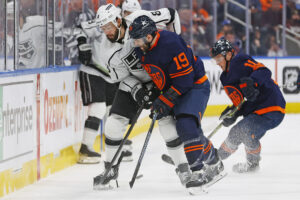Here at Last Word we take a look at the analytics with respect to how the Tampa Bay Lightning pass the puck around to generate offence.
The art of passing is underrated when analyzing the game of hockey. The NHL offers scarce passing data, only recognizing the assists that result in goals. What about the rest of the passes that don’t result in goals? That’s where hand-tracking micro statistics come in.
Offensive Zone Passing Analytics From the Tampa Bay Lightning First Two Games
Hand-tracking data is a tedious process. A popular name in the microstats department is Corey Sznajder. He has tracked data from over 3,000 NHL games since the 2016 season. Microstats provide fans with a more detailed explanation of NHL games. In addition, we can break down the game into different categories and understand player archetypes.
Exploring My Data
This project focuses specifically on the Tampa Bay Lightning. We at LWOS Hockey Department are looking to track roughly 20 games throughout the regular season. We will analyze passing, zone entries, zone exits, and transition statistics. Let’s see how the Lightning is doing with offensive zone passing through their first two games.
Offensive Zone Passing Glossary
The offensive zone passing glossary has four categories.
High Danger Passes
High-danger passes travel through the middle of the zone, like a cross-ice seam pass. These passes typically travel through the slot and drive shooting percentages extremely high. Whenever the puck moves laterally, the goalie must travel from post to post, placing him out of position. Getting the goaltender out of position increases the probability of scoring. High-danger passes are the most difficult to replicate and involve the most risk. However, these passes are exceptionally effective in the offence.
The other passes categorized as “high-danger” are passes from behind the net to the slot. The defenders start to puck-watch and lose their defensive zone coverage. Their skates point down the ice. Moreover, the goalie must turn their head to track the puck. When passes are fired from behind directly to the slot, the defenders and goalies often don’t react in time.
Offensive Zone Cycle Passes
In studying the Tampa Bay Lightning analytics, we determine that offensive zone cycle passes are passes that build the attack. These can be classified as rims along the boards and passes throughout the zone. These passes show which players are best at maintaining puck possession. Building off puck possession tires out opposing defenders and increases pressure. Eventually, when defenders experience fatigue, they are more prone to mistakes, resulting in quality scoring chances.
Passes to Point
Point passes are passes made by forwards only to defencemen at the blue line. These passes will be a common trend because of the Tampa Bay offensive zone structure. The team plays a “2-3” press with three players high in the zone. The other two forwards screen the goaltender and look for deflections. The Lightning creates chaos in the zone from these passes.
D to D Passes
These passes are when the defencemen exchange the puck with one another in the offensive zone. They usually shift the angle of attack and change the shot location. These passes are tracked for defencemen only.
The Results
High-Danger Leaders
Nikita Kucherov leads the team in high-danger passes at even strength with five. Kucherov is a master of feathering passes through the middle of the ice. His art of deception and one-timers constantly place the goaltender out of position. His high-danger work explains his and his linemates’ ability to outscore their expected goals every season. Brandon Hagel ranks second in high-danger passes with three. Hagel is coming off a 30-goal breakout campaign in 2023. He will continue to be a top contributor for the Lightning moving forward.
| Kucherov | 5 |
| Hagel | 3 |
| Stamkos | 1 |
| Point | 1 |
| Cirelli | 1 |
| Hedman | 1 |
Offensive Zone Cycle Leaders
The Lightning did a much better job maintaining zone time in the first game. The club struggled to stay in the zone for game two, generating a more rush-based attack. Steven Stamkos is the leader in the cycle game currently with 11 passes. Stamkos moves the puck quickly in the zone down-low. He uses the give-and-go and scissor-cycle to confuse defenders. Mikhail Sergachev finds players at the top of the zone for shot opportunities. He moves the puck laterally to shift the angle of attack. In addition, Anthony Cirelli and Conor Sheary work through the high slot effectively. These two tend to make tighter touch passes before zipping one across the ice for the ultimate shot attempt.
| Stamkos | 11 |
| Sergachev | 9 |
| Cirelli | 8 |
| Sheary | 8 |
| Perbix | 7 |
| Raddysh | 7 |
| Kucherov | 7 |
| Point | 7 |
Pass to Point Leaders
The point passes allow the Lightning to reload the attack and set up their offensive zone structure. This statistic is tracked for forwards only. Kucherov leads the roster with six passes to the point. A trend is that one player on the line uses the point to reset the attack for the entire shift. On line two, Hagel dominates with five passes to the point. On line three, Michael Eyssimont also has five-point passes.
| Kucherov | 6 |
| Hagel | 5 |
| Eyssimont | 5 |
| Paul | 2 |
| Sheary | 2 |
| Jeannot | 2 |
D To D Leaders
While these passes are the least significant, they provide context on how the defencemen move the puck. These defencemen stretch the ice, using its width. Keep in mind these are tracked for defenders only. Calvin de Haan leads the back end with seven “D to D” passes. Sergachev ranks second with six passes of this type.
| de Haan | 7 |
| Sergachev | 6 |
| Cernak | 3 |
| Perbix | 3 |
Future of the Tracking Project
In separate articles, expect a glossary for the transition, breakout, and power play aspects of passing. In addition, transitional statistics will discussed. Microstats are a fantastic tool to build context and a deeper understanding of hockey. I encourage every fan to use them.
Main photo: Danny Wild-USA TODAY Sports






